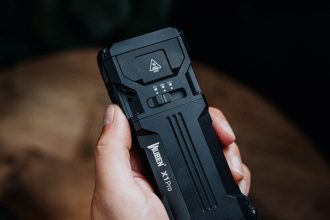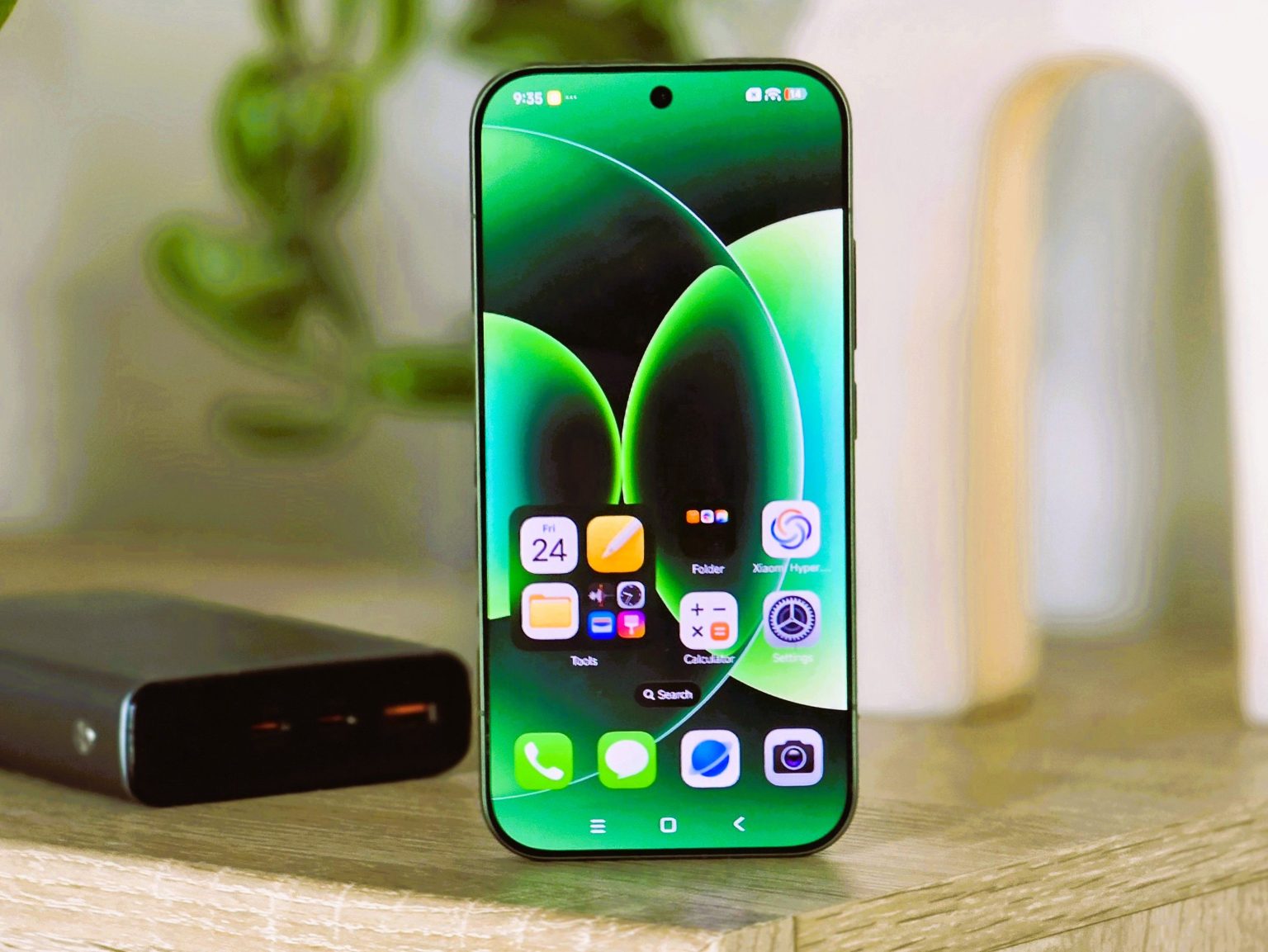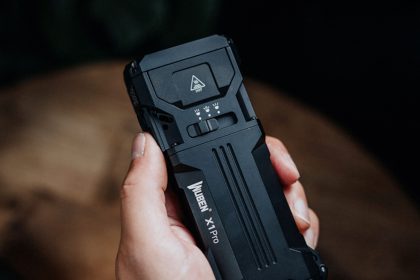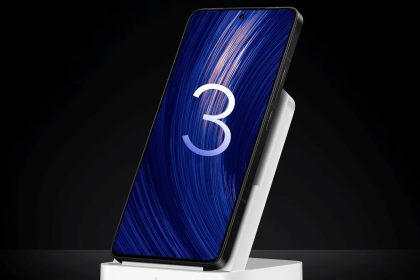The Xiaomi 17 Pro is a compact, powerful and premium-feeling, top-of-the-line smartphone. Despite having a slightly smaller battery than the Xiaomi 17, it still has excellent staying power.
The Pro model’s real highlight and unique selling point is the secondary display. However, it is currently more of a nice-to-have than a must-have for potential buyers. Its future hinges on integrating third-party apps that would turn its current limited functionality into genuine added value in everyday situations.
As long as you don’t mind importing the Chinese version and its associated drawbacks in Europe (no Android Auto, no eSIM, etc.), you can’t go wrong with this small flagship phone. For around $800, there’s nothing comparable or available in this country.
Pros+ Bright OLED panel
+ Long battery life
+ Powerful SoC
+ Good camera package
+ Secondary display
Cons- Uncertain update timeframe
– High heat output
– SoC throttling
– Availability currently only in China
– Chinese version limitations
– Second screen functionality
In China, the Xiaomi 17 Pro’s recommended retail price starts at 4,999 yuan (approximately $693). Import prices from our device lender, Trading Shenzhen, start at around $879. Unfortunately, due to the previous model’s unavailability, we can safely expect the Pro model not to make it to Europe this year either.
For the first time, Xiaomi has delivered a competitor to Apple’s compact Pro model. The new Xiaomi 17 Pro comes in an ergonomic 6.3-inch form factor and is only slightly pared back compared to the Xiaomi 17 Pro Max. The highlight is on the rear of the device – a 2.7-inch AMOLED panel boasting a 120Hz refresh rate and high brightness.
Display
6.30 inch 19.5:9, 2656 x 1220 pixel 464 PPI, capacitive Touchscreen, LTPO AMOLED, Secondary display (on the back): LTPO AMOLED, 120Hz, Dolby Vision, HDR Vivid, HDR10+, 3500 nits (peak) 2.7 inches, 572 x 904 pixels, HDR, 120 Hz
Storage
1TB UFS 4.1 Flash, 1024 GB
, 970 GB free
Connections
1 USB 3.0 / 3.1 Gen1, USB-C Power Delivery (PD), 1 HDMI, 1 DisplayPort, 1 Infrared, Audio Connections: USB-C, 1 Fingerprint Reader, NFC, Brightness Sensor, Sensors: accelerometer, proximity, gyro, compass, barometer, UWB, Miracast, OTG
Networking
802.11 a/b/g/n/ac/ax/be (a/b/g/n = Wi-Fi 4/ac = Wi-Fi 5/ax = Wi-Fi 6/ Wi-Fi 6E 6 GHz be = Wi-Fi 7), Bluetooth 6.0, 5G:n1 / n2 / n3 / n5 / n7 / n8 / n12 / n18 / n20 / n25 / n26 / n28 / n38 / n40 / n41 / n48 / n66 / n77 / n78 / n80 / n81 / n83 / n84 / n89 ; 4G:FDD-LTE:B1 / B2 / B3 / B4 / B5 / B7 / B8 / B12 / B17 / B18 / B19 / B20 / B25 / B26 / B28 / B66 TDD-LTE:B34 / B38 / B39 / B40 / B41 / B42 / B48; 3G:WCDMA:B1 / B2 / B4 / B5 / B6 / B8 / B19; 2G:GSM:B2 / B3 / B5 / B8, Dual SIM, LTE, 5G, GPS
Size
height x width x depth (in mm): 8 x 151.1 x 71.8 ( = 0.31 x 5.95 x 2.83 in)
Battery
6300 mAh Silicon-Carbon
Charging
wireless charging, fast charging / Quickcharge
Operating System
Android 16
Camera
Primary Camera: 50 MPix (f/1.7, 23 mm, 1/1.28″, 1.22 µm, OIS) + 50 MPix (f/3.0, 115 mm, periscope telephoto, OIS, 5x optical zoom, macro) + 50 MPix (f/2.4, 17 mm, ultrawide, 1/2.76″, 0.64µm)
Secondary Camera: 50 MPix (f/2.2, 21 mm, PDAF)
Additional features
Speakers: Stereo, charger, USB cable, case, HyperOS 3, 12 Months Warranty, GPS (L1+L5), BDS (B1I+B1c+B2a), GALILEO (E1+E5a), QZSS (L1+L5), NavIC (L5), GLONASS | IP68 | Dolby Vision, HDR Vivid, HDR10+, fanless, waterproof
Weight
192 g ( = 6.77 oz / 0.42 pounds), Power Supply: 105 g ( = 3.7 oz / 0.23 pounds)
Note: The manufacturer may use components from different suppliers including display panels, drives or memory sticks with similar specifications.
Xiaomi 17 Pro color optionsThe Xiaomi 17 Pro is housed in a compact and exceptionally well-made body that feels premium to the touch. The frame is constructed from aluminum, and Xiaomi uses Dragon Crystal Glass to protect the front and back. Thanks to its IP68 certification, the flagship phone is also highly resistant to both dust and water.
With a high screen-to-body ratio of 89.5 percent, the display covers almost the entire front side of the phone, resulting in a modern design. The 2.7-inch LTPO OLED display on the back is located next to the cameras. It is a particularly noteworthy highlight, which adds to both the form and function.
Sony Xperia 1 VII Xiaomi 15 Pro Samsung Galaxy S25+ Google Pixel 10 Pro Xiaomi 17 Pro Apple iPhone 17 DIN A6 ❌
162 mm / 6.38 in
74 mm / 2.91 in
8.2 mm / 0.3228 in
197 g0.4343 lbs161.3 mm / 6.35 in
75.3 mm / 2.96 in
8.7 mm / 0.3425 in
213 g0.4696 lbs158.4 mm / 6.24 in
75.8 mm / 2.98 in
7.3 mm / 0.2874 in
190 g0.4189 lbs152.8 mm / 6.02 in
72 mm / 2.83 in
8.6 mm / 0.3386 in
207 g0.4564 lbs151.1 mm / 5.95 in
71.8 mm / 2.83 in
8 mm / 0.315 in
192 g0.4233 lbs149.6 mm / 5.89 in
71.5 mm / 2.81 in
7.95 mm / 0.313 in
177 g0.3902 lbs148 mm / 5.83 in
105 mm / 4.13 in
1 mm / 0.03937 in
1.5 g0.00331 lbs
The Xiaomi 17 Pro’s Ultra Wideband (UWB) support allows for precise location tracking, and its integrated IR blaster can control compatible devices such as TVs or air conditioners.
It also features Miracast, NFC, and a fast USB-C port that complies with the USB 3.2 standard.
In addition to video output, this port also supports USB OTG, which allows you to connect external peripherals.
The Xiaomi 17 Pro uses Xiaomi’s in-house HyperOS 3, which is based on Android 16. As is typical for the Chinese versions of Xiaomi phones, its software supports only a few language packs. Although neither German nor the Play Store is pre-installed, the latter can be easily installed.
No information has been provided regarding the duration of software updates. During our review period, the security patches were from October 2025 – in other words, very up-to-date.
We were unable to locate precise information regarding the materials used or an official CO2 balance for the latest Xiaomi generation. This means neither the smartphone’s overall ecological footprint nor its repairability can be assessed.
In our tests, the Xiaomi 17 Pro’s fast Wi-Fi 7 enabled high data speeds and a stable connection. When paired with the Asus ROG Rapture GT-AXE11000 reference router, the flagship phone achieved transfer speeds of over 1,000 Mbps. Despite this, we see some room for improvement, particularly on the 6 GHz frequency band.
Thanks to its broad support for 5G and 4G frequencies (including the important bands 20 and 28), the Xiaomi smartphone can be used without any issues in German-speaking countries, even as an imported device.
NetworkingXiaomi 17 Pro
802.11 a/b/g/n/ac/ax/be iperf3 transmit AXE11000
1076 (min: 975) MBit/s ∼98%
iperf3 receive AXE11000
1264 (min: 1065) MBit/s ∼79%
iperf3 transmit AXE11000 6GHz
1113 (min: 1045) MBit/s ∼71%
iperf3 receive AXE11000 6GHz
1292 (min: 1201) MBit/s ∼74%
Sony Xperia 1 VII
802.11 a/b/g/n/ac/ax/be iperf3 transmit AXE11000
868 (min: 791) MBit/s ∼79%
iperf3 receive AXE11000
755 (min: 722) MBit/s ∼47%
iperf3 transmit AXE11000 6GHz
1142 (min: 920) MBit/s ∼73%
iperf3 receive AXE11000 6GHz
1359 (min: 679) MBit/s ∼78%
Samsung Galaxy S25+
Wi-Fi 7 iperf3 transmit AXE11000
1094 (min: 655) MBit/s ∼100%
iperf3 receive AXE11000
1154 (min: 1048) MBit/s ∼72%
iperf3 transmit AXE11000 6GHz
1311 (min: 984) MBit/s ∼83%
iperf3 receive AXE11000 6GHz
1204 (min: 1187) MBit/s ∼69%
Apple iPhone 17
802.11 a/b/g/n/ac/ax/be iperf3 transmit AXE11000
777 (min: 620) MBit/s ∼71%
iperf3 receive AXE11000
1592 (min: 1420) MBit/s ∼100%
iperf3 transmit AXE11000 6GHz
1020 (min: 745) MBit/s ∼65%
iperf3 receive AXE11000 6GHz
1658 (min: 1579) MBit/s ∼95%
Google Pixel 10 Pro
802.11 a/b/g/n/ac/ax/be iperf3 transmit AXE11000
928 (min: 844) MBit/s ∼85%
iperf3 receive AXE11000
916 (min: 903) MBit/s ∼58%
iperf3 transmit AXE11000 6GHz
1571 MBit/s ∼100%
iperf3 receive AXE11000 6GHz
1742 (min: 1566) MBit/s ∼100%
Xiaomi 15 Pro
Wi-Fi 7 iperf3 transmit AXE11000 6GHz
816 (min: 564) MBit/s ∼52%
iperf3 receive AXE11000 6GHz
1520 (min: 1364) MBit/s ∼87%
Average 802.11 a/b/g/n/ac/ax/be
iperf3 transmit AXE11000
944 (min: 595) MBit/s ∼86%
iperf3 receive AXE11000
1093 (min: 459) MBit/s ∼69%
iperf3 transmit AXE11000 6GHz
1293 (min: 508) MBit/s ∼82%
iperf3 receive AXE11000 6GHz
1446 (min: 719) MBit/s ∼83%
Average of class Smartphone
iperf3 transmit AXE11000
715 (min: 49.8) MBit/s ∼65%
iperf3 receive AXE11000
743 (min: 52) MBit/s ∼47%
iperf3 transmit AXE11000 6GHz
1355 (min: 508) MBit/s ∼86%
iperf3 receive AXE11000 6GHz
1402 (min: 451) MBit/s ∼80%
0501001502002503003504004505005506006507007508008509009501000105011001150120012501300135014001450150015501600TooltipXiaomi 17 Pro 802.11 a/b/g/n/ac/ax/be; iperf3 transmit AXE11000 6GHz: Ø1113 (1045-1192)
Xiaomi 15 Pro Wi-Fi 7; iperf3 transmit AXE11000 6GHz; iperf 3.1.3: Ø816 (564-966)
Xiaomi 17 Pro 802.11 a/b/g/n/ac/ax/be; iperf3 receive AXE11000 6GHz: Ø1292 (1201-1351)
Xiaomi 15 Pro Wi-Fi 7; iperf3 receive AXE11000 6GHz; iperf 3.1.3: Ø1520 (1364-1602)
Xiaomi 17 Pro 802.11 a/b/g/n/ac/ax/be; iperf3 transmit AXE11000: Ø1076 (975-1179)
Xiaomi 17 Pro 802.11 a/b/g/n/ac/ax/be; iperf3 receive AXE11000: Ø1264 (1065-1369)
Outdoors, the Xiaomi 17 Pro quickly acquired a satellite signal and pinpointed its location with an accuracy of 3 meters. It utilizes major global satellite networks in dual-band mode for positioning.
In our real-life testing, together with a reference smartwatch (Garmin Venu 2), the compact flagship phone performed very well. Deviations from the actual distance travelled were minimal.
Voice transmission was pleasant and natural, and the Xiaomi 17 Pro supports common features such as Wi-Fi calling, VoLTE, as well as dual SIM. An eSIM cannot be used with a Chinese import device.
Xiaomi has equipped the Xiaomi 17 Pro with a new 1/1.28-inch, highly dynamic Light Hunter 950L sensor. The manufacturer of the image sensor is not officially known, but according to sources in China, the sensor (SC590XS) is from SmartSens. The rear mini-display allows the main camera to also be used for selfies.
The Xiaomi 17 Pro delivers impressive results thanks to excellent sharpness and fast shutter speeds. Although the photos’ dynamic range is also very good, the color accuracy could be a bit better. In low light, the compact flagship phone impressed us with minimal blurriness and a wealth of detail.
The Leica triple-camera system is combined with a solid ultra-wide camera and a telephoto lens with lossless 5x zoom. Zoomed-in shots are very respectable in daylight situations and quite usable up to 10x hybrid zoom.
Image comparison
Choose a scene and navigate within the first image. One click changes the position on touchscreens. One click on the zoomed-in image opens the original in a new window. The first image shows the scaled photograph of the test device.
Main cameraMain cameraLow lightUltra-wide-angle
click to load images
12.8 ∆E
8.4 ∆E
16.5 ∆E
16.3 ∆E
12.1 ∆E
7 ∆E
6.6 ∆E
17.8 ∆E
8.5 ∆E
8.2 ∆E
9.3 ∆E
5.4 ∆E
13 ∆E
17.6 ∆E
10 ∆E
1.9 ∆E
10.4 ∆E
17.1 ∆E
5.8 ∆E
1.4 ∆E
9.2 ∆E
14.4 ∆E
6.3 ∆E
3.4 ∆E
ColorChecker Xiaomi 17 Pro: 9.97 ∆E min: 1.36 – max: 17.84 ∆E14.2 ∆E
6.7 ∆E
6.9 ∆E
12.4 ∆E
8.5 ∆E
6.1 ∆E
14.5 ∆E
7.2 ∆E
6 ∆E
9.1 ∆E
8.2 ∆E
12.8 ∆E
7.5 ∆E
12.2 ∆E
5.3 ∆E
4.9 ∆E
7.6 ∆E
10.2 ∆E
10.7 ∆E
9 ∆E
7.7 ∆E
11.1 ∆E
13.8 ∆E
10.8 ∆E
ColorChecker Xiaomi 17 Pro: 9.31 ∆E min: 4.87 – max: 14.47 ∆EAmong the range of items included in the box are a 100-watt power adapter, a protective case, and a charging cable. A screen protector also comes pre-installed. Additionally, our rental supplier, Trading Shenzhen, has included an EU adapter.
Our imported device comes with a 12-month warranty. Should a warranty claim arise, Trading Shenzhen offers the option of sending the smartphone to a German shipping address.
Thanks to its compact design, the buttons find themselves in very ergonomic locations. Inputs on the 6.3-inch AMOLED display are accurately registered, and in everyday situations, the Xiaomi 17 Pro runs smoothly, with animations appearing fluid. One feature that particularly impressed us was the vibration motor.
The small display on the rear of the device is also easy to use, but it didn’t offer any significant added value during our testing period.
The 3D ultrasonic fingerprint sensor for biometric user recognition unlocks the Xiaomi phone quickly and reliably. A rather insecure 2D face recognition feature, based on a face unlock function using the front camera, is also on board.
Subpixel arrangement The 6.3-inch LTPO AMOLED panel boasts a high resolution and a 120 Hz maximum refresh rate, which can be adaptively reduced to 1 Hz.
While our measurements on a white background yielded a peak brightness of only around 1,000 cd/m², we achieved an excellent 3,412 cd/m² using the more relevant APL18 test pattern. This corresponds to the advertised peak brightness of 3,500 nits and is responsible for excellent HDR effects.
As is usually the case with OLED displays, screen brightness is controlled using PWM modulation. This results in screen flicker and, according to the manufacturer, includes eye protection (frequency: 2,160 Hz). Our display measurements revealed a base flicker of approximately 120 Hz.
1026
cd/m²1034
cd/m²1055
cd/m²1063
cd/m²1071
cd/m²1044
cd/m²1043
cd/m²1053
cd/m²1046
cd/m²
Distribution of brightness
tested with X-Rite i1Pro 3
Maximum: 1071 cd/m² (Nits) Average: 1048.3 cd/m² Minimum: 1.1 cd/m²
Brightness Distribution: 96 %
Center on Battery: 1071 cd/m²
Contrast: ∞:1 (Black: 0 cd/m²)
ΔE ColorChecker Calman: 0.98 | ∀{0.5-29.43 Ø4.79}
ΔE Greyscale Calman: 1.2 | ∀{0.09-98 Ø5}
102.8% sRGB (Calman 2D)
Gamma: 2.221
CCT: 6703 K
Xiaomi 17 Pro
LTPO AMOLED, 2656×1220, 6.3″Sony Xperia 1 VII
OLED, 2340×1080, 6.5″Samsung Galaxy S25+
Dynamic AMOLED 2X, 3120×1440, 6.7″Apple iPhone 17
OLED, 2622×1206, 6.3″Google Pixel 10 Pro
OLED, 2856×1280, 6.3″Xiaomi 15 Pro
AMOLED, 3200×1440, 6.7″Screen-59%
-41%
-10%
50%
-20%
Brightness middle (cd/m²)1071
1441
35%
1371
28%
1138
6%
2161
102%
1016
-5%
Brightness (cd/m²)1048
1450
38%
1370
31%
1127
8%
2198
110%
1017
-3%
Brightness Distribution (%)96
99
3%
96
0%
96
0%
94
-2%
98
2%
Black Level * (cd/m²)Colorchecker dE 2000 *0.98
3.2
-227%
2.7
-176%
1.07
-9%
0.7
29%
1.15
-17%
Colorchecker dE 2000 max. *2.58
4.6
-78%
4.2
-63%
2.99
-16%
1.8
30%
3.57
-38%
Greyscale dE 2000 *1.2
2.7
-125%
2
-67%
1.8
-50%
0.8
33%
1.9
-58%
Gamma2.221 99%
2.19 100%
2.03 108%
2.22 99%
2.19 100%
2.2 100%
CCT6703 97%
6476 100%
6450 101%
6516 100%
6646 98%
6677 97%
* … smaller is better
Screen Flickering / PWM (Pulse-Width Modulation)ℹ
To dim the screen, some notebooks will simply cycle the backlight on and off in rapid succession – a method called Pulse Width Modulation (PWM) . This cycling frequency should ideally be undetectable to the human eye. If said frequency is too low, users with sensitive eyes may experience strain or headaches or even notice the flickering altogether.
Screen flickering / PWM detected 120 Hz
Amplitude: 19 %The display backlight flickers at 120 Hz (worst case, e.g., utilizing PWM) .
The frequency of 120 Hz is very low, so the flickering may cause eyestrain and headaches after extended use.
In comparison: 53 % of all tested devices do not use PWM to dim the display. If PWM was detected, an average of 8152 (minimum: 5 – maximum: 343500) Hz was measured.
A series of measurements with a fixed zoom level and different brightness settings (The amplitude curve at minimum brightness appears flat, but this is due to the scaling. The enlarged version of the amplitude at minimum brightness can be seen in the info box.)
The color calibration and grayscale deviations are very minor. The Xiaomi 17 Pro also offers color display settings, but HyperOS 3 no longer supports the extensive customization options found in its predecessor.
Display Response Timesℹ
Display response times show how fast the screen is able to change from one color to the next. Slow response times can lead to afterimages and can cause moving objects to appear blurry (ghosting). Gamers of fast-paced 3D titles should pay special attention to fast response times.
↔ Response Time Black to White0.6 ms … rise ↗ and fall ↘ combined↗ 0.3 ms rise↘ 0.3 ms fallThe screen shows very fast response rates in our tests and should be very well suited for fast-paced gaming.
In comparison, all tested devices range from 0.1 (minimum) to 240 (maximum) ms. » 1 % of all devices are better.
This means that the measured response time is better than the average of all tested devices (20.3 ms). ↔ Response Time 50% Grey to 80% Grey0.7 ms … rise ↗ and fall ↘ combined↗ 0.3 ms rise↘ 0.4 ms fallThe screen shows very fast response rates in our tests and should be very well suited for fast-paced gaming.
In comparison, all tested devices range from 0.165 (minimum) to 636 (maximum) ms. » 2 % of all devices are better.
This means that the measured response time is better than the average of all tested devices (31.7 ms).
Outdoors, the compact flagship phone is very impressive. Given its light weight, the displayed content is very legible, and the viewing angle stability is also excellent.
Anyone on the hunt for one of the best currently available SoCs will be well served by the Snapdragon 8 Elite Gen 5. The 4.6 GHz peak clock speed resulted in high Geekbench scores in single-core tests, but the multi-core results were particularly outstanding. However, the Qualcomm chipset still has room for improvement regarding AI benchmarks.
Geekbench 6.5
Single-CoreApple iPhone 17
Apple A19, A19 GPU, 8192
3732 Points +4%
Average Qualcomm Snapdragon 8 Elite Gen 5
(3587 – 3831, n=5)
3692 Points +3%
Xiaomi 17 Pro
Qualcomm Snapdragon 8 Elite Gen 5, Adreno 840, 16384
3587 Points
Samsung Galaxy S25+
Qualcomm Snapdragon 8 Elite for Galaxy, Adreno 830, 12288
3136 Points -13%
Xiaomi 15 Pro
Qualcomm Snapdragon 8 Elite, Adreno 830, 16384
3089 Points -14%
Sony Xperia 1 VII
Qualcomm Snapdragon 8 Elite, Adreno 830, 12288
3003 Points -16%
Google Pixel 10 Pro
Google Tensor G5, DXT-48-1536, 16384
2308 Points -36%
Average of class Smartphone
(196 – 3883, n=213, last 2 years)
1727 Points -52%
Multi-CoreAverage Qualcomm Snapdragon 8 Elite Gen 5
(10620 – 12383, n=5)
11255 Points +4%
Xiaomi 17 Pro
Qualcomm Snapdragon 8 Elite Gen 5, Adreno 840, 16384
10798 Points
Samsung Galaxy S25+
Qualcomm Snapdragon 8 Elite for Galaxy, Adreno 830, 12288
10029 Points -7%
Apple iPhone 17
Apple A19, A19 GPU, 8192
9456 Points -12%
Xiaomi 15 Pro
Qualcomm Snapdragon 8 Elite, Adreno 830, 16384
9404 Points -13%
Sony Xperia 1 VII
Qualcomm Snapdragon 8 Elite, Adreno 830, 12288
9129 Points -15%
Google Pixel 10 Pro
Google Tensor G5, DXT-48-1536, 16384
6314 Points -42%
Average of class Smartphone
(830 – 11634, n=213, last 2 years)
5048 Points -53%
Antutu v10 – Total Score
Average Qualcomm Snapdragon 8 Elite Gen 5
(2390211 – 3269237, n=4)
2692258 Points +5%
Xiaomi 15 Pro
Qualcomm Snapdragon 8 Elite, Adreno 830, 16384
2611586 Points +2%
Xiaomi 17 Pro
Qualcomm Snapdragon 8 Elite Gen 5, Adreno 840, 16384
2564453 Points
Samsung Galaxy S25+
Qualcomm Snapdragon 8 Elite for Galaxy, Adreno 830, 12288
2271821 Points -11%
Sony Xperia 1 VII
Qualcomm Snapdragon 8 Elite, Adreno 830, 12288
2209192 Points -14%
Apple iPhone 17
Apple A19, A19 GPU, 8192
2158729 Points -16%
Average of class Smartphone
(142748 – 3269237, n=154, last 2 years)
1459419 Points -43%
Google Pixel 10 Pro
Google Tensor G5, DXT-48-1536, 16384
1338955 Points -48%
PCMark for Android – Work 3.0
Average Qualcomm Snapdragon 8 Elite Gen 5
(19432 – 28557, n=4)
22175 Points +6%
Xiaomi 17 Pro
Qualcomm Snapdragon 8 Elite Gen 5, Adreno 840, 16384
20878 Points
Samsung Galaxy S25+
Qualcomm Snapdragon 8 Elite for Galaxy, Adreno 830, 12288
20673 Points -1%
Sony Xperia 1 VII
Qualcomm Snapdragon 8 Elite, Adreno 830, 12288
20028 Points -4%
Xiaomi 15 Pro
Qualcomm Snapdragon 8 Elite, Adreno 830, 16384
18231 Points -13%
Google Pixel 10 Pro
Google Tensor G5, DXT-48-1536, 16384
15738 Points -25%
Average of class Smartphone
(4507 – 28557, n=190, last 2 years)
14715 Points -30%
BaseMark OS II
OverallXiaomi 17 Pro
Qualcomm Snapdragon 8 Elite Gen 5, Adreno 840, 16384
14076 Points
Average Qualcomm Snapdragon 8 Elite Gen 5
(12929 – 14076, n=3)
13663 Points -3%
Samsung Galaxy S25+
Qualcomm Snapdragon 8 Elite for Galaxy, Adreno 830, 12288
13223 Points -6%
Sony Xperia 1 VII
Qualcomm Snapdragon 8 Elite, Adreno 830, 12288
12414 Points -12%
Xiaomi 15 Pro
Qualcomm Snapdragon 8 Elite, Adreno 830, 16384
9067 Points -36%
Google Pixel 10 Pro
Google Tensor G5, DXT-48-1536, 16384
8446 Points -40%
Average of class Smartphone
(1196 – 14076, n=148, last 2 years)
7505 Points -47%
SystemXiaomi 17 Pro
Qualcomm Snapdragon 8 Elite Gen 5, Adreno 840, 16384
19244 Points
Average Qualcomm Snapdragon 8 Elite Gen 5
(18137 – 19244, n=3)
18863 Points -2%
Samsung Galaxy S25+
Qualcomm Snapdragon 8 Elite for Galaxy, Adreno 830, 12288
17481 Points -9%
Sony Xperia 1 VII
Qualcomm Snapdragon 8 Elite, Adreno 830, 12288
17069 Points -11%
Xiaomi 15 Pro
Qualcomm Snapdragon 8 Elite, Adreno 830, 16384
14976 Points -22%
Google Pixel 10 Pro
Google Tensor G5, DXT-48-1536, 16384
12881 Points -33%
Average of class Smartphone
(2368 – 20776, n=148, last 2 years)
11233 Points -42%
MemoryXiaomi 17 Pro
Qualcomm Snapdragon 8 Elite Gen 5, Adreno 840, 16384
16984 Points
Sony Xperia 1 VII
Qualcomm Snapdragon 8 Elite, Adreno 830, 12288
16511 Points -3%
Samsung Galaxy S25+
Qualcomm Snapdragon 8 Elite for Galaxy, Adreno 830, 12288
16264 Points -4%
Average Qualcomm Snapdragon 8 Elite Gen 5
(13505 – 16984, n=3)
15818 Points -7%
Average of class Smartphone
(962 – 20652, n=148, last 2 years)
8500 Points -50%
Xiaomi 15 Pro
Qualcomm Snapdragon 8 Elite, Adreno 830, 16384
7873 Points -54%
Google Pixel 10 Pro
Google Tensor G5, DXT-48-1536, 16384
7257 Points -57%
GraphicsAverage Qualcomm Snapdragon 8 Elite Gen 5
(52356 – 53231, n=3)
52655 Points +1%
Xiaomi 17 Pro
Qualcomm Snapdragon 8 Elite Gen 5, Adreno 840, 16384
52378 Points
Samsung Galaxy S25+
Qualcomm Snapdragon 8 Elite for Galaxy, Adreno 830, 12288
45691 Points -13%
Xiaomi 15 Pro
Qualcomm Snapdragon 8 Elite, Adreno 830, 16384
44154 Points -16%
Sony Xperia 1 VII
Qualcomm Snapdragon 8 Elite, Adreno 830, 12288
43710 Points -17%
Google Pixel 10 Pro
Google Tensor G5, DXT-48-1536, 16384
30035 Points -43%
Average of class Smartphone
(1046 – 384996, n=148, last 2 years)
25183 Points -52%
WebSamsung Galaxy S25+
Qualcomm Snapdragon 8 Elite for Galaxy, Adreno 830, 12288
2353 Points +4%
Xiaomi 17 Pro
Qualcomm Snapdragon 8 Elite Gen 5, Adreno 840, 16384
2257 Points
Average Qualcomm Snapdragon 8 Elite Gen 5
(2143 – 2257, n=3)
2211 Points -2%
Sony Xperia 1 VII
Qualcomm Snapdragon 8 Elite, Adreno 830, 12288
1928 Points -15%
Google Pixel 10 Pro
Google Tensor G5, DXT-48-1536, 16384
1813 Points -20%
Average of class Smartphone
(858 – 2363, n=148, last 2 years)
1678 Points -26%
Xiaomi 15 Pro
Qualcomm Snapdragon 8 Elite, Adreno 830, 16384
1278 Points -43%
UL Procyon AI Inference for Android – Overall Score NNAPI
Samsung Galaxy S25+
Qualcomm Snapdragon 8 Elite for Galaxy, Adreno 830, 12288
23141 Points 0%
Xiaomi 17 Pro
Qualcomm Snapdragon 8 Elite Gen 5, Adreno 840, 16384
23122 Points
Average Qualcomm Snapdragon 8 Elite Gen 5
(22372 – 23712, n=4)
23071 Points 0%
Xiaomi 15 Pro
Qualcomm Snapdragon 8 Elite, Adreno 830, 16384
21254 Points -8%
Average of class Smartphone
(3769 – 81594, n=139, last 2 years)
19882 Points -14%
Sony Xperia 1 VII
Qualcomm Snapdragon 8 Elite, Adreno 830, 12288
19260 Points -17%
Google Pixel 10 Pro
Google Tensor G5, DXT-48-1536, 16384
17652 Points -24%
AImark – Score v3.x
Apple iPhone 17
Apple A19, A19 GPU, 8192
35717 Points
Average of class Smartphone
(82 – 307528, n=127, last 2 years)
27193 Points
Xiaomi 15 Pro
Qualcomm Snapdragon 8 Elite, Adreno 830, 16384
1987 Points
Sony Xperia 1 VII
Qualcomm Snapdragon 8 Elite, Adreno 830, 12288
1903 Points
Samsung Galaxy S25+
Qualcomm Snapdragon 8 Elite for Galaxy, Adreno 830, 12288
1891 Points
Average Qualcomm Snapdragon 8 Elite Gen 5
(1455 – 2381, n=3)
1875 Points
Google Pixel 10 Pro
Google Tensor G5, DXT-48-1536, 16384
1477 Points
Geekbench AI
Single Precision NPU 1.5Apple iPhone 17
Apple A19, A19 GPU, 8192
4677 Points +626%
Average of class Smartphone
(80 – 5210, n=49, last 2 years)
863 Points +34%
Xiaomi 17 Pro
Qualcomm Snapdragon 8 Elite Gen 5, Adreno 840, 16384
644 Points
Sony Xperia 1 VII
Qualcomm Snapdragon 8 Elite, Adreno 830, 12288
628 Points -2%
Average Qualcomm Snapdragon 8 Elite Gen 5
(524 – 698, n=4)
603 Points -6%
Google Pixel 10 Pro
Google Tensor G5, DXT-48-1536, 16384
478 Points -26%
Half Precision NPU 1.5Apple iPhone 17
Apple A19, A19 GPU, 8192
35502 Points +5152%
Average of class Smartphone
(80 – 36297, n=49, last 2 years)
4046 Points +499%
Google Pixel 10 Pro
Google Tensor G5, DXT-48-1536, 16384
907 Points +34%
Xiaomi 17 Pro
Qualcomm Snapdragon 8 Elite Gen 5, Adreno 840, 16384
676 Points
Sony Xperia 1 VII
Qualcomm Snapdragon 8 Elite, Adreno 830, 12288
634 Points -6%
Average Qualcomm Snapdragon 8 Elite Gen 5
(486 – 676, n=4)
596 Points -12%
Quantized NPU 1.5Apple iPhone 17
Apple A19, A19 GPU, 8192
48896 Points +3164%
Average of class Smartphone
(133 – 49889, n=49, last 2 years)
5757 Points +284%
Google Pixel 10 Pro
Google Tensor G5, DXT-48-1536, 16384
3792 Points +153%
Xiaomi 17 Pro
Qualcomm Snapdragon 8 Elite Gen 5, Adreno 840, 16384
1498 Points
Sony Xperia 1 VII
Qualcomm Snapdragon 8 Elite, Adreno 830, 12288
1274 Points -15%
Average Qualcomm Snapdragon 8 Elite Gen 5
(974 – 1498, n=4)
1240 Points -17%
The Adreno 840 GPU chip built into the Snapdragon 8 Elite Gen 5 achieved very good, but not the highest scores in GFXBench. Even demanding games should run smoothly on the Xiaomi 17 Pro, with the 4K test yielding a strong 49fps.
3DMark / Wild Life Extreme Unlimited
Samsung Galaxy S25+
Adreno 830, SD 8 Elite f. Galaxy, 256 GB UFS 4.0 Flash
6885 Points +1%
Xiaomi 17 Pro
Adreno 840, SD 8 Elite Gen 5, 1TB UFS 4.1 Flash
6843 Points
Sony Xperia 1 VII
Adreno 830, SD 8 Elite, 256 GB UFS 4.0 Flash
6588 Points -4%
Xiaomi 15 Pro
Adreno 830, SD 8 Elite, 1 TB UFS 4.0 Flash
6521 Points -5%
Apple iPhone 17
A19 GPU, A19, 256 GB NVMe
4904 Points -28%
Google Pixel 10 Pro
DXT-48-1536, Tensor G5, 256 GB UFS 4.0 Flash
3232 Points -53%
3DMark / Wild Life Extreme
Samsung Galaxy S25+
Adreno 830, SD 8 Elite f. Galaxy, 256 GB UFS 4.0 Flash
7029 Points +2%
Xiaomi 17 Pro
Adreno 840, SD 8 Elite Gen 5, 1TB UFS 4.1 Flash
6897 Points
Xiaomi 15 Pro
Adreno 830, SD 8 Elite, 1 TB UFS 4.0 Flash
6567 Points -5%
Sony Xperia 1 VII
Adreno 830, SD 8 Elite, 256 GB UFS 4.0 Flash
6108 Points -11%
Apple iPhone 17
A19 GPU, A19, 256 GB NVMe
5022 Points -27%
Google Pixel 10 Pro
DXT-48-1536, Tensor G5, 256 GB UFS 4.0 Flash
3281 Points -52%
3DMark / Wild Life Unlimited Score
Samsung Galaxy S25+
Adreno 830, SD 8 Elite f. Galaxy, 256 GB UFS 4.0 Flash
26616 Points +4%
Xiaomi 17 Pro
Adreno 840, SD 8 Elite Gen 5, 1TB UFS 4.1 Flash
25687 Points
Xiaomi 15 Pro
Adreno 830, SD 8 Elite, 1 TB UFS 4.0 Flash
25431 Points -1%
Sony Xperia 1 VII
Adreno 830, SD 8 Elite, 256 GB UFS 4.0 Flash
25174 Points -2%
Apple iPhone 17
A19 GPU, A19, 256 GB NVMe
21785 Points -15%
Google Pixel 10 Pro
DXT-48-1536, Tensor G5, 256 GB UFS 4.0 Flash
13193 Points -49%
3DMark / Solar Bay Score
Xiaomi 17 Pro
Adreno 840, SD 8 Elite Gen 5, 1TB UFS 4.1 Flash
12656 Points
Samsung Galaxy S25+
Adreno 830, SD 8 Elite f. Galaxy, 256 GB UFS 4.0 Flash
12400 Points -2%
Xiaomi 15 Pro
Adreno 830, SD 8 Elite, 1 TB UFS 4.0 Flash
11654 Points -8%
Sony Xperia 1 VII
Adreno 830, SD 8 Elite, 256 GB UFS 4.0 Flash
10802 Points -15%
Apple iPhone 17
A19 GPU, A19, 256 GB NVMe
10197 Points -19%
3DMark / Solar Bay Unlimited Score
Samsung Galaxy S25+
Adreno 830, SD 8 Elite f. Galaxy, 256 GB UFS 4.0 Flash
12747 Points +1%
Xiaomi 17 Pro
Adreno 840, SD 8 Elite Gen 5, 1TB UFS 4.1 Flash
12679 Points
Sony Xperia 1 VII
Adreno 830, SD 8 Elite, 256 GB UFS 4.0 Flash
11890 Points -6%
Xiaomi 15 Pro
Adreno 830, SD 8 Elite, 1 TB UFS 4.0 Flash
11589 Points -9%
Apple iPhone 17
A19 GPU, A19, 256 GB NVMe
10389 Points -18%
3DMark / Steel Nomad Light Unlimited Score
Xiaomi 17 Pro
Adreno 840, SD 8 Elite Gen 5, 1TB UFS 4.1 Flash
2732 Points
Xiaomi 15 Pro
Adreno 830, SD 8 Elite, 1 TB UFS 4.0 Flash
2602 Points -5%
Samsung Galaxy S25+
Adreno 830, SD 8 Elite f. Galaxy, 256 GB UFS 4.0 Flash
2525 Points -8%
Sony Xperia 1 VII
Adreno 830, SD 8 Elite, 256 GB UFS 4.0 Flash
2269 Points -17%
Apple iPhone 17
A19 GPU, A19, 256 GB NVMe
2124 Points -22%
Google Pixel 10 Pro
DXT-48-1536, Tensor G5, 256 GB UFS 4.0 Flash
1013 Points -63%
3DMark / Steel Nomad Light Score
Xiaomi 17 Pro
Adreno 840, SD 8 Elite Gen 5, 1TB UFS 4.1 Flash
2707 (20min – 20max) Points
Samsung Galaxy S25+
Adreno 830, SD 8 Elite f. Galaxy, 256 GB UFS 4.0 Flash
2698 Points 0%
Xiaomi 15 Pro
Adreno 830, SD 8 Elite, 1 TB UFS 4.0 Flash
2576 Points -5%
Sony Xperia 1 VII
Adreno 830, SD 8 Elite, 256 GB UFS 4.0 Flash
2303 Points -15%
Apple iPhone 17
A19 GPU, A19, 256 GB NVMe
2197 Points -19%
Google Pixel 10 Pro
DXT-48-1536, Tensor G5, 256 GB UFS 4.0 Flash
1014 Points -63%
GFXBench (DX / GLBenchmark) 2.7 / T-Rex Onscreen
Google Pixel 10 Pro
DXT-48-1536, Tensor G5, 256 GB UFS 4.0 Flash
121 fps +1%
Xiaomi 15 Pro
Adreno 830, SD 8 Elite, 1 TB UFS 4.0 Flash
120 fps 0%
Samsung Galaxy S25+
Adreno 830, SD 8 Elite f. Galaxy, 256 GB UFS 4.0 Flash
120 fps 0%
Xiaomi 17 Pro
Adreno 840, SD 8 Elite Gen 5, 1TB UFS 4.1 Flash
120 fps
Sony Xperia 1 VII
Adreno 830, SD 8 Elite, 256 GB UFS 4.0 Flash
120 fps 0%
Apple iPhone 17
A19 GPU, A19, 256 GB NVMe
60 fps -50%
GFXBench (DX / GLBenchmark) 2.7 / T-Rex Offscreen
Xiaomi 17 Pro
Adreno 840, SD 8 Elite Gen 5, 1TB UFS 4.1 Flash
798 fps
Xiaomi 15 Pro
Adreno 830, SD 8 Elite, 1 TB UFS 4.0 Flash
763 fps -4%
Sony Xperia 1 VII
Adreno 830, SD 8 Elite, 256 GB UFS 4.0 Flash
749 fps -6%
Samsung Galaxy S25+
Adreno 830, SD 8 Elite f. Galaxy, 256 GB UFS 4.0 Flash
697 fps -13%
Apple iPhone 17
A19 GPU, A19, 256 GB NVMe
534.3 fps -33%
Google Pixel 10 Pro
DXT-48-1536, Tensor G5, 256 GB UFS 4.0 Flash
406 fps -49%
GFXBench 3.0 / Manhattan Onscreen OGL
Google Pixel 10 Pro
DXT-48-1536, Tensor G5, 256 GB UFS 4.0 Flash
121 fps +1%
Xiaomi 15 Pro
Adreno 830, SD 8 Elite, 1 TB UFS 4.0 Flash
120 fps 0%
Samsung Galaxy S25+
Adreno 830, SD 8 Elite f. Galaxy, 256 GB UFS 4.0 Flash
120 fps 0%
Xiaomi 17 Pro
Adreno 840, SD 8 Elite Gen 5, 1TB UFS 4.1 Flash
120 fps
Sony Xperia 1 VII
Adreno 830, SD 8 Elite, 256 GB UFS 4.0 Flash
120 fps 0%
Apple iPhone 17
A19 GPU, A19, 256 GB NVMe
60 fps -50%
GFXBench 3.0 / 1080p Manhattan Offscreen
Samsung Galaxy S25+
Adreno 830, SD 8 Elite f. Galaxy, 256 GB UFS 4.0 Flash
450 fps +21%
Xiaomi 15 Pro
Adreno 830, SD 8 Elite, 1 TB UFS 4.0 Flash
423 fps +14%
Sony Xperia 1 VII
Adreno 830, SD 8 Elite, 256 GB UFS 4.0 Flash
421 fps +13%
Xiaomi 17 Pro
Adreno 840, SD 8 Elite Gen 5, 1TB UFS 4.1 Flash
371 fps
Apple iPhone 17
A19 GPU, A19, 256 GB NVMe
338.5 fps -9%
Google Pixel 10 Pro
DXT-48-1536, Tensor G5, 256 GB UFS 4.0 Flash
282 fps -24%
GFXBench 3.1 / Manhattan ES 3.1 Onscreen
Xiaomi 15 Pro
Adreno 830, SD 8 Elite, 1 TB UFS 4.0 Flash
120 fps 0%
Samsung Galaxy S25+
Adreno 830, SD 8 Elite f. Galaxy, 256 GB UFS 4.0 Flash
120 fps 0%
Xiaomi 17 Pro
Adreno 840, SD 8 Elite Gen 5, 1TB UFS 4.1 Flash
120 fps
Sony Xperia 1 VII
Adreno 830, SD 8 Elite, 256 GB UFS 4.0 Flash
120 fps 0%
Google Pixel 10 Pro
DXT-48-1536, Tensor G5, 256 GB UFS 4.0 Flash
119 fps -1%
Apple iPhone 17
A19 GPU, A19, 256 GB NVMe
60 fps -50%
GFXBench 3.1 / Manhattan ES 3.1 Offscreen
Xiaomi 17 Pro
Adreno 840, SD 8 Elite Gen 5, 1TB UFS 4.1 Flash
346 fps
Xiaomi 15 Pro
Adreno 830, SD 8 Elite, 1 TB UFS 4.0 Flash
308 fps -11%
Sony Xperia 1 VII
Adreno 830, SD 8 Elite, 256 GB UFS 4.0 Flash
285 fps -18%
Samsung Galaxy S25+
Adreno 830, SD 8 Elite f. Galaxy, 256 GB UFS 4.0 Flash
283 fps -18%
Apple iPhone 17
A19 GPU, A19, 256 GB NVMe
230 fps -34%
Google Pixel 10 Pro
DXT-48-1536, Tensor G5, 256 GB UFS 4.0 Flash
207 fps -40%
GFXBench / Car Chase Onscreen
Xiaomi 15 Pro
Adreno 830, SD 8 Elite, 1 TB UFS 4.0 Flash
120 fps 0%
Samsung Galaxy S25+
Adreno 830, SD 8 Elite f. Galaxy, 256 GB UFS 4.0 Flash
120 fps 0%
Xiaomi 17 Pro
Adreno 840, SD 8 Elite Gen 5, 1TB UFS 4.1 Flash
120 fps
Sony Xperia 1 VII
Adreno 830, SD 8 Elite, 256 GB UFS 4.0 Flash
120 fps 0%
Apple iPhone 17
A19 GPU, A19, 256 GB NVMe
60 fps -50%
Google Pixel 10 Pro
DXT-48-1536, Tensor G5, 256 GB UFS 4.0 Flash
59 fps -51%
GFXBench / Car Chase Offscreen
Xiaomi 15 Pro
Adreno 830, SD 8 Elite, 1 TB UFS 4.0 Flash
209 fps +5%
Xiaomi 17 Pro
Adreno 840, SD 8 Elite Gen 5, 1TB UFS 4.1 Flash
199 fps
Sony Xperia 1 VII
Adreno 830, SD 8 Elite, 256 GB UFS 4.0 Flash
195 fps -2%
Samsung Galaxy S25+
Adreno 830, SD 8 Elite f. Galaxy, 256 GB UFS 4.0 Flash
178 fps -11%
Apple iPhone 17
A19 GPU, A19, 256 GB NVMe
164.8 fps -17%
Google Pixel 10 Pro
DXT-48-1536, Tensor G5, 256 GB UFS 4.0 Flash
81 fps -59%
GFXBench / Aztec Ruins High Tier Onscreen
Samsung Galaxy S25+
Adreno 830, SD 8 Elite f. Galaxy, 256 GB UFS 4.0 Flash
120 fps 0%
Xiaomi 17 Pro
Adreno 840, SD 8 Elite Gen 5, 1TB UFS 4.1 Flash
120 fps
Sony Xperia 1 VII
Adreno 830, SD 8 Elite, 256 GB UFS 4.0 Flash
120 fps 0%
Xiaomi 15 Pro
Adreno 830, SD 8 Elite, 1 TB UFS 4.0 Flash
106 fps -12%
Google Pixel 10 Pro
DXT-48-1536, Tensor G5, 256 GB UFS 4.0 Flash
64 fps -47%
Apple iPhone 17
A19 GPU, A19, 256 GB NVMe
60 fps -50%
GFXBench / Aztec Ruins High Tier Offscreen
Sony Xperia 1 VII
Adreno 830, SD 8 Elite, 256 GB UFS 4.0 Flash
115 fps +4%
Xiaomi 15 Pro
Adreno 830, SD 8 Elite, 1 TB UFS 4.0 Flash
112 fps +1%
Xiaomi 17 Pro
Adreno 840, SD 8 Elite Gen 5, 1TB UFS 4.1 Flash
111 fps
Samsung Galaxy S25+
Adreno 830, SD 8 Elite f. Galaxy, 256 GB UFS 4.0 Flash
107 fps -4%
Apple iPhone 17
A19 GPU, A19, 256 GB NVMe
69.8 fps -37%
Google Pixel 10 Pro
DXT-48-1536, Tensor G5, 256 GB UFS 4.0 Flash
55 fps -50%
GFXBench / Aztec Ruins Normal Tier Onscreen
Xiaomi 15 Pro
Adreno 830, SD 8 Elite, 1 TB UFS 4.0 Flash
120 fps 0%
Samsung Galaxy S25+
Adreno 830, SD 8 Elite f. Galaxy, 256 GB UFS 4.0 Flash
120 fps 0%
Xiaomi 17 Pro
Adreno 840, SD 8 Elite Gen 5, 1TB UFS 4.1 Flash
120 fps
Sony Xperia 1 VII
Adreno 830, SD 8 Elite, 256 GB UFS 4.0 Flash
120 fps 0%
Google Pixel 10 Pro
DXT-48-1536, Tensor G5, 256 GB UFS 4.0 Flash
94 fps -22%
Apple iPhone 17
A19 GPU, A19, 256 GB NVMe
60 fps -50%
GFXBench / Aztec Ruins Normal Tier Offscreen
Xiaomi 17 Pro
Adreno 840, SD 8 Elite Gen 5, 1TB UFS 4.1 Flash
292 fps
Samsung Galaxy S25+
Adreno 830, SD 8 Elite f. Galaxy, 256 GB UFS 4.0 Flash
286 fps -2%
Sony Xperia 1 VII
Adreno 830, SD 8 Elite, 256 GB UFS 4.0 Flash
285 fps -2%
Xiaomi 15 Pro
Adreno 830, SD 8 Elite, 1 TB UFS 4.0 Flash
276 fps -5%
Apple iPhone 17
A19 GPU, A19, 256 GB NVMe
202.5 fps -31%
Google Pixel 10 Pro
DXT-48-1536, Tensor G5, 256 GB UFS 4.0 Flash
127 fps -57%
GFXBench / 4K Aztec Ruins High Tier Offscreen
Samsung Galaxy S25+
Adreno 830, SD 8 Elite f. Galaxy, 256 GB UFS 4.0 Flash
52 fps +2%
Xiaomi 17 Pro
Adreno 840, SD 8 Elite Gen 5, 1TB UFS 4.1 Flash
51 fps
Sony Xperia 1 VII
Adreno 830, SD 8 Elite, 256 GB UFS 4.0 Flash
49 fps -4%
Xiaomi 15 Pro
Adreno 830, SD 8 Elite, 1 TB UFS 4.0 Flash
48 fps -6%
Apple iPhone 17
A19 GPU, A19, 256 GB NVMe
29.6 fps -42%
Google Pixel 10 Pro
DXT-48-1536, Tensor G5, 256 GB UFS 4.0 Flash
25 fps -51%
Jetstream 2 – 2.2 Total Score
Apple iPhone 17 (Safari Mobile 26)
467.799 Points +111%
Sony Xperia 1 VII (Chrome 139.0.7258.160)
307.255 Points +39%
Google Pixel 10 Pro (Chrome 140)
274.298 Points +24%
Average of class Smartphone (2 – 469, n=42, last 2 years)
222 Points 0%
Xiaomi 17 Pro (Chrome 141)
221.233 Points
Average Qualcomm Snapdragon 8 Elite Gen 5 (2 – 325, n=3)
182.6 Points -17%
WebXPRT 4 – Overall
Apple iPhone 17 (Safari Mobile 26)
290 Points +138%
Xiaomi 15 Pro (Chrome 132)
255 Points +109%
Samsung Galaxy S25+ (Chrome 133.0.6943.137)
239 Points +96%
Google Pixel 10 Pro (Chrome 140)
177 Points +45%
Average Qualcomm Snapdragon 8 Elite Gen 5 (102 – 278, n=4)
154 Points +26%
Sony Xperia 1 VII (Chrome 139.0.7258.160)
149 Points +22%
Average of class Smartphone (27 – 306, n=149, last 2 years)
145 Points +19%
Xiaomi 17 Pro (Chrome 141)
122 Points
Octane V2 – Total Score
Apple iPhone 17 (Safari Mobile 26)
110696 Points +81%
Samsung Galaxy S25+ (Chrome 133.0.6943.137)
98817 Points +61%
Sony Xperia 1 VII (Chrome 139.0.7258.160)
87682 Points +43%
Xiaomi 15 Pro (Chrome 132)
84676 Points +38%
Google Pixel 10 Pro (Chrome 140)
84055 Points +37%
Average Qualcomm Snapdragon 8 Elite Gen 5 (50987 – 99417, n=4)
76542 Points +25%
Xiaomi 17 Pro (Chrome 141)
61238 Points
Average of class Smartphone (2228 – 121337, n=202, last 2 years)
48387 Points -21%
Mozilla Kraken 1.1 – Total
Average of class Smartphone (257 – 28190, n=157, last 2 years)
1182 ms * -131%
Xiaomi 17 Pro (Chrome 141)
511.76 ms *
Sony Xperia 1 VII (Chrome 139.0.7258.160)
501.2 ms * +2%
Average Qualcomm Snapdragon 8 Elite Gen 5 (306 – 635, n=4)
475 ms * +7%
Google Pixel 10 Pro (Chrome 140)
472.5 ms * +8%
Xiaomi 15 Pro (Chrome 132)
423.11 ms * +17%
Samsung Galaxy S25+ (Chrome 133.0.6943.137)
388.7 ms * +24%
Apple iPhone 17 (Safari Mobile 26)
263.1 ms * +49%
* … smaller is better
Xiaomi 17 ProSony Xperia 1 VIISamsung Galaxy S25+Google Pixel 10 ProXiaomi 15 ProAverage 1TB UFS 4.1 FlashAverage of class SmartphoneAndroBench 3-5173%
88%
46%
147%
113%
64%
Sequential Read 256KB (MB/s)3876.97
3847.82
-1%
4057.35
5%
1492.74
-61%
3998.65
3%
3689 ?(3220 – 3971, n=3)
-5%
2203 ?(270 – 4370, n=194, last 2 years)
-43%
Sequential Write 256KB (MB/s)3790.66
2936.71
-23%
3311.02
-13%
1353.55
-64%
3673.38
-3%
3761 ?(3593 – 3900, n=3)
-1%
1819 ?(103.2 – 4035, n=194, last 2 years)
-52%
Random Read 4KB (MB/s)58.82
477
711%
294.51
401%
264.44
350%
409.67
596%
344 ?(58.8 – 548, n=3)
485%
292 ?(47.6 – 548, n=194, last 2 years)
396%
Random Write 4KB (MB/s)598.39
613.9
3%
351.16
-41%
347.84
-42%
555.55
-7%
423 ?(110.5 – 598, n=3)
-29%
335 ?(9.4 – 964, n=194, last 2 years)
-44%
We recorded high surface temperatures, and while the Pro model performs somewhat better than the Xiaomi 17, thermally induced throttling is very noticeable. In the 3DMark stress tests, the compact flagship phone’s performance dropped by 30 percent.
46.5 °C
116 F45.5 °C
114 F40.2 °C
104 F 48.2 °C
119 F46.1 °C
115 F45.2 °C
113 F 48.7 °C
120 F47.2 °C
117 F42.2 °C
108 F
Maximum: 48.7 °C = 120 F
Average: 45.5 °C = 114 F
39.3 °C
103 F43 °C
109 F43.2 °C
110 F49.2 °C
121 F43 °C
109 F45.7 °C
114 F40.6 °C
105 F43.5 °C
110 F46.8 °C
116 F
Maximum: 49.2 °C = 121 F
Average: 43.8 °C = 111 F Power Supply (max.) 41.3 °C = 106 F | Room Temperature 20 °C = 68 F | Fluke t3000FC (calibrated), Voltcraft IR-260
(-) The average temperature for the upper side under maximal load is 45.5 °C / 114 F, compared to the average of 32.9 °C / 91 F for the devices in the class Smartphone.
(-) The maximum temperature on the upper side is 48.7 °C / 120 F, compared to the average of 35.2 °C / 95 F, ranging from 21.9 to 247 °C for the class Smartphone.
(-) The bottom heats up to a maximum of 49.2 °C / 121 F, compared to the average of 34 °C / 93 F
(+) In idle usage, the average temperature for the upper side is 25.3 °C / 78 F, compared to the device average of 32.9 °C / 91 F.
3DMark
Wild Life Stress Test StabilityApple iPhone 17
A19 GPU, A19, 256 GB NVMe
96.8 % +32%
Google Pixel 10 Pro
DXT-48-1536, Tensor G5, 256 GB UFS 4.0 Flash
81.2 % +10%
Xiaomi 15 Pro
Adreno 830, SD 8 Elite, 1 TB UFS 4.0 Flash
75.3 % +2%
Xiaomi 17 Pro
Adreno 840, SD 8 Elite Gen 5, 1TB UFS 4.1 Flash
73.6 %
Sony Xperia 1 VII
Adreno 830, SD 8 Elite, 256 GB UFS 4.0 Flash
61.6 % -16%
Samsung Galaxy S25+
Adreno 830, SD 8 Elite f. Galaxy, 256 GB UFS 4.0 Flash
53.4 % -27%
Wild Life Extreme Stress TestGoogle Pixel 10 Pro
DXT-48-1536, Tensor G5, 256 GB UFS 4.0 Flash
88.7 % +27%
Xiaomi 15 Pro
Adreno 830, SD 8 Elite, 1 TB UFS 4.0 Flash
75.8 % +8%
Xiaomi 17 Pro
Adreno 840, SD 8 Elite Gen 5, 1TB UFS 4.1 Flash
69.9 %
Apple iPhone 17
A19 GPU, A19, 256 GB NVMe
65.4 % -6%
Sony Xperia 1 VII
Adreno 830, SD 8 Elite, 256 GB UFS 4.0 Flash
63.7 % -9%
Samsung Galaxy S25+
Adreno 830, SD 8 Elite f. Galaxy, 256 GB UFS 4.0 Flash
51.3 % -27%
Solar Bay Stress Test StabilityXiaomi 15 Pro
Adreno 830, SD 8 Elite, 1 TB UFS 4.0 Flash
83.8 % +27%
Apple iPhone 17
A19 GPU, A19, 256 GB NVMe
66.1 % 0%
Xiaomi 17 Pro
Adreno 840, SD 8 Elite Gen 5, 1TB UFS 4.1 Flash
65.8 %
Sony Xperia 1 VII
Adreno 830, SD 8 Elite, 256 GB UFS 4.0 Flash
60 % -9%
Samsung Galaxy S25+
Adreno 830, SD 8 Elite f. Galaxy, 256 GB UFS 4.0 Flash
58.9 % -10%
0102030405060708090100110120130TooltipXiaomi 17 Pro Adreno 840, SD 8 Elite Gen 5, 1TB UFS 4.1 Flash; Wild Life Extreme Stress Test; 1.1.14.1: Ø30.8 (28.1-40.2)
Xiaomi 15 Pro Adreno 830, SD 8 Elite, 1 TB UFS 4.0 Flash; Wild Life Extreme Stress Test; 1.1.4.1: Ø28.8 (26.6-35)
Xiaomi 17 Pro Adreno 840, SD 8 Elite Gen 5, 1TB UFS 4.1 Flash; Wild Life Stress Test Stability; 0.0.0.0: Ø107 (100.1-135.9)
Xiaomi 15 Pro Adreno 830, SD 8 Elite, 1 TB UFS 4.0 Flash; Wild Life Stress Test Stability; 0.0.0.0: Ø103.5 (96.3-128)
Xiaomi 17 Pro Adreno 840, SD 8 Elite Gen 5, 1TB UFS 4.1 Flash; Solar Bay Stress Test Stability; 1.0.17.2: Ø30.9 (26.9-40.9)
Xiaomi 15 Pro Adreno 830, SD 8 Elite, 1 TB UFS 4.0 Flash; Solar Bay Stress Test Stability; 1.0.11.1: Ø29.4 (28.1-33.5)
Xiaomi 15 Pro Adreno 830, SD 8 Elite, 1 TB UFS 4.0 Flash; Steel Nomad Light Stress Test Stability; 1.1.1.3: Ø15.2 (13.9-18.1)
The stereo speakers offer excellent sound for a compact device. Headphones can be connected via a wired USB port, but anyone preferring Bluetooth for wireless output can do so by taking advantage of a wide range of codecs and the new 6.0 standard.
dB(A)
0102030405060708090Deep BassMiddle BassHigh BassLower RangeMidsHigher MidsLower HighsMid HighsUpper HighsSuper Highs2045.8402537.236.83127.331.74035355045.645.46327.627.98017.627.610020.341.112517.150.416019.755.620016.96025015.961.131517.460.240016.958.850017.360.963021.663.380020.568.2100018.469.9125018.570.1160017.572.9200014.574.9250014.669.8315014.365.7400016.475.5500019.578.7630021.278.4800021.872.61000019.670.11250019.274.41600016.764.4SPL30.885.6N1.462.7median 17.5median 68.2Delta1.66.134.939.124.331.220.729.418.126.430.83621.731.114.828.317.237.214.342.517.155.714.355.514.258.114.561.31364.911.87113.274.810.972.911.775.111.477.811.778.512.380.71380.712.88112.477.213.973.613.572.11367.413.666.313.765.31354.724.889.30.676.1median 13median 72.11.29.2hearing rangehide median Pink NoiseXiaomi 17 ProGoogle Pixel 10 ProFrequency diagram (checkboxes can be checked and unchecked to compare devices)
Xiaomi 17 Pro audio analysis(+) | speakers can play relatively loud (85.6 dB)
Bass 100 – 315 Hz
(±) | reduced bass – on average 13.5% lower than median
(±) | linearity of bass is average (11.3% delta to prev. frequency)
Mids 400 – 2000 Hz
(+) | balanced mids – only 4.6% away from median
(+) | mids are linear (4.3% delta to prev. frequency)
Highs 2 – 16 kHz
(±) | higher highs – on average 5.5% higher than median
(±) | linearity of highs is average (8.7% delta to prev. frequency)
Overall 100 – 16.000 Hz
(+) | overall sound is linear (14.9% difference to median)
Compared to same class
» 2% of all tested devices in this class were better, 2% similar, 96% worse
» The best had a delta of 11%, average was 35%, worst was 134%
Compared to all devices tested
» 19% of all tested devices were better, 4% similar, 77% worse
» The best had a delta of 4%, average was 24%, worst was 134%
Google Pixel 10 Pro audio analysis(+) | speakers can play relatively loud (89.3 dB)
Bass 100 – 315 Hz
(-) | nearly no bass – on average 20.4% lower than median
(±) | linearity of bass is average (9.4% delta to prev. frequency)
Mids 400 – 2000 Hz
(+) | balanced mids – only 4.4% away from median
(+) | mids are linear (4.9% delta to prev. frequency)
Highs 2 – 16 kHz
(±) | higher highs – on average 5% higher than median
(+) | highs are linear (3.6% delta to prev. frequency)
Overall 100 – 16.000 Hz
(±) | linearity of overall sound is average (16.1% difference to median)
Compared to same class
» 5% of all tested devices in this class were better, 4% similar, 91% worse
» The best had a delta of 11%, average was 35%, worst was 134%
Compared to all devices tested
» 25% of all tested devices were better, 5% similar, 70% worse
» The best had a delta of 4%, average was 24%, worst was 134%
The 6,300 mAh battery housed inside the Xiaomi 17 Pro can be charged with modern PPS chargers at up to 100 watts. Wireless charging is also possible at a maximum of 50 watts. With a fast charger, we achieved charging times of 35 minutes.
Power consumption proved to be efficient both when running idle and under load.
Xiaomi 17 Pro
6300 mAhSony Xperia 1 VII
5000 mAhSamsung Galaxy S25+
4900 mAhApple iPhone 17
3692 mAhGoogle Pixel 10 Pro
4870 mAhXiaomi 15 Pro
6100 mAhAverage Qualcomm Snapdragon 8 Elite Gen 5
Average of class Smartphone
Power Consumption-3%
-45%
-26%
-51%
7%
-7%
-18%
Idle Minimum * (Watt)0.8
0.42
47%
0.45
44%
1.1
-38%
1.01
-26%
0.6
25%
0.733 ?(0.6 – 0.83, n=4)
8%
0.851 ?(0.4 – 1.65, n=161, last 2 years)
-6%
Idle Average * (Watt)1.4
0.93
34%
1.09
22%
1.3
7%
1.65
-18%
0.9
36%
1.433 ?(0.8 – 2.13, n=4)
-2%
1.431 ?(0.6 – 4.36, n=161, last 2 years)
-2%
Idle Maximum * (Watt)1.8
0.95
47%
1.13
37%
1.5
17%
2.05
-14%
1.1
39%
1.77 ?(1.4 – 2.18, n=4)
2%
1.61 ?(0.85 – 4.46, n=161, last 2 years)
11%
Load Average * (Watt)4.2
8.62
-105%
14.41
-243%
7.6
-81%
7.25
-73%
6.7
-60%
5.53 ?(4.2 – 6.5, n=3)
-32%
7.08 ?(2.3 – 16.5, n=141, last 2 years)
-69%
Load Maximum * (Watt)8.9
12.47
-40%
16.37
-84%
12
-35%
19.78
-122%
9.5
-7%
9.9 ?(8.9 – 11.7, n=3)
-11%
11.1 ?(3.53 – 20.8, n=141, last 2 years)
-25%
* … smaller is better
0123456789TooltipXiaomi 17 Pro Qualcomm Snapdragon 8 Elite Gen 5; Geekbench 5.5 Power Consumption 150cd: Ø4.83 (0.858-8.78)
Xiaomi 15 Pro Qualcomm Snapdragon 8 Elite; Geekbench 5.5 Power Consumption 150cd: Ø5.51 (0.64-9.38)
Xiaomi 17 Pro Qualcomm Snapdragon 8 Elite Gen 5; Idle 150cd/m2: Ø0.874 (0.773-1.176)
Xiaomi 15 Pro Qualcomm Snapdragon 8 Elite; Idle 150cd/m2: Ø0.622 (0.528-0.962)
0123456789TooltipXiaomi 17 Pro Qualcomm Snapdragon 8 Elite Gen 5; 1920×1080 Aztec Ruins Normal Offscreen: Ø8.54 (8.47-8.58)
Xiaomi 15 Pro Qualcomm Snapdragon 8 Elite; 1920×1080 Aztec Ruins Normal Offscreen: Ø9.37 (9.34-9.41)
Xiaomi 17 Pro Qualcomm Snapdragon 8 Elite Gen 5; Idle 150cd/m2: Ø0.874 (0.773-1.176)
Xiaomi 15 Pro Qualcomm Snapdragon 8 Elite; Idle 150cd/m2: Ø0.622 (0.528-0.962)
The Xiaomi 17 Pro’s large battery capacity is responsible for excellent battery life. With adjusted display brightness (150 cd/m²), we managed almost 30 hours of use while browsing via Wi-Fi.
Battery Runtime
WiFi Websurfing (Chrome 141)
29h 39min
Unfortunately, the Xiaomi 17 Pro is a great smartphone that will probably never be officially released in Germany. Its secondary display definitely requires some software improvements before offering any real added value.
Xiaomi 17 Pro
– 10/27/2025 v8
Marcus Herbrich
Connectivity
69 / 69 → 100%
Games Performance
46 / 55 → 83%
Application Performance
84 / 85 → 98%
Smartphone – Weighted Average
CO2 Emissions
No Data
Materials
25%
Packaging
70%
Power Use
96.1%
Repairability
30%
Software Updates
66.7%
Total Sustainability Score: 48%
Image
Model / Review
Price
Weight
Drive
Display
1.
90.5%
Xiaomi 17 Pro
Qualcomm Snapdragon 8 Elite Gen 5 ⎘
Qualcomm Adreno 840 ⎘
16 GB Memory, 1024 GB Amazon:
1. $9.90
Anbzsign 2+1 Pack for Xiaomi…
2. $6.93
Milomdoi 3 Pack Privacy Scre…
3. $344.99
Xiaomi Redmi Note 13 PRO+ 5G…
List Price: 650€192 g1TB UFS 4.1 Flash6.30″
2656×1220
464 PPI
LTPO AMOLED
2.
88.5%
Sony Xperia 1 VII
Qualcomm Snapdragon 8 Elite ⎘
Qualcomm Adreno 830 ⎘
12 GB Memory, 256 GB List Price: 1499€197 g256 GB UFS 4.0 Flash6.50″
2340×1080
396 PPI
OLED
3.
88.4%
Samsung Galaxy S25+
Qualcomm Snapdragon 8 Elite for Galaxy ⎘
Qualcomm Adreno 830 ⎘
12 GB Memory, 256 GB Amazon:
1. $1,090.00
SAMSUNG Galaxy S25 Ultra, 25…
2. $649.99
Samsung Galaxy S25 FE Cell P…
3. $7.98
firtstnow 3 Pack Glass Scree…
List Price: 1149 Euro190 g256 GB UFS 4.0 Flash6.70″
3120×1440
513 PPI
Dynamic AMOLED 2X
4.
87.9%
Apple iPhone 17
Apple A19 ⎘
Apple A19 GPU ⎘
8 GB Memory, 256 GB NVMeAmazon:
1.
iPhone 17 Pro Deep Blue 256GB
2.
iPhone 17 Pro Max Deep Blue …
3.
iPhone 17 Black 256GB
List Price: 949 Euro177 g256 GB NVMe6.30″
2622×1206
460 PPI
OLED
5.
88.9%
Google Pixel 10 Pro
Google Tensor G5 ⎘
IMG DXT-48-1536 ⎘
16 GB Memory, 256 GB Amazon: $1,099.00
List Price: 1199€207 g256 GB UFS 4.0 Flash6.30″
2856×1280
497 PPI
OLED
6.
89.9%
Xiaomi 15 Pro
Qualcomm Snapdragon 8 Elite ⎘
Qualcomm Adreno 830 ⎘
16 GB Memory, 1024 GB Amazon:
1. $4.99
Kicvbnco 3 Pack For Xiaomi 1…
2. $16.95
IPG Made for Xiaomi 15 Pro H…
3.
AKABEILA [3 Pack Privacy Scr…
List Price: 810€213 g1 TB UFS 4.0 Flash6.73″
3200×1440
521 PPI
AMOLED
More articles related to this deviceXiaomi 17 Pro (17 Series)
Related Articles
TransparencyThe selection of devices to be reviewed is made by our editorial team. The test sample was provided to the author as a loan by the manufacturer or retailer for the purpose of this review. The lender had no influence on this review, nor did the manufacturer receive a copy of this review before publication. There was no obligation to publish this review. As an independent media company, Notebookcheck is not subjected to the authority of manufacturers, retailers or publishers.
This is how Notebookcheck is testing
Every year, Notebookcheck independently reviews hundreds of laptops and smartphones using standardized procedures to ensure that all results are comparable. We have continuously developed our test methods for around 20 years and set industry standards in the process. In our test labs, high-quality measuring equipment is utilized by experienced technicians and editors. These tests involve a multi-stage validation process. Our complex rating system is based on hundreds of well-founded measurements and benchmarks, which maintains objectivity. Further information on our test methods can be found here.
I have always been very passionately interested in mobile technologies, especially smartphones. Being a tech enthusiast means the half-life of my devices isn’t exactly long, and being the latest hardware is not enough to suffice as the manufacturer and operating system play a minor role – the most important aspect for me is that the device is state-of-the-art. After posting for Mobi Test I joined Notebookcheck in 2016, where I have been pursuing my enthusiasm for technology by reviewing the latest smartphone, tablet, and accessory trends.
Translator: Andrew Dickson – Translator – 170 articles published on Notebookcheck since 2022
My lifelong passion for tech was born in a gadget-filled household in Scotland. From games consoles to cameras to computers. Early adopters, so early the phrase might have been coined with our family in mind.
On finishing school, I trained and qualified as a golf professional before moving to Germany, where I have worked and lived for over 30 years.
In 2002, I formed a successful English language centre, providing training, translations and digital learning systems to numerous businesses in the Rhein Neckar metropole area.
Whether augmented or virtual reality, smart devices, mobile technology, sustainable environmental solutions, the tech world is as exciting now as it has ever been.
Working with Notebookcheck allows me to combine my love of both tech and language.
Marcus Herbrich, 2025-10-31 (Update: 2025-10-31)












